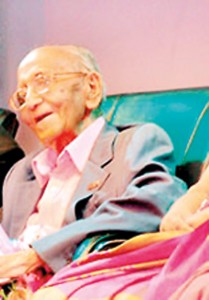Why I brought Village in the Jungle to the screen
Lester James Peries (LJP), the legend of Sinhala cinema, defies age. When I visited him last week, he, with wife Sumitra by his side, was full of verve and wit on current issues.

The veteran: Lester James Peries
His 96+ years have in no way diminished his spirit but have added to his personality. This was further in evidence when he spoke with great enthusiasm about “Baddegama”, the film he made 25 years ago and the travails he went through in bringing Leonard Woolf’s celebrated novel “Village in the Jungle” to the silver screen.
Justifying the efforts he made to bring the novel closer to Lankan viewers, he said ‘Village in the Jungle’ is a masterpiece, authored by a literary giant of the twentieth century – the only fiction written by a colonial ruler on Lankans.
The novel projected the lives of peasants in a village surrounded by the jungles of Hambantota. The author, who was the Government Agent of the Hambantota District and thus himself an agent of imperialism, revealed the insensitivities and injustices of the colonial masters. Woolf was also one of the first who saw the cracks in the British Empire.
LJP was attracted not just by the narrative and literary excellence alone. He saw its sociological and political relevance which pushed him to search for a Sinhala translation.
He found a book written by A.P. Gunaratne who had given it the title “Baddegama” the title used for the film as well when its Sinhala script was written by the late Professor A.J. Gunawardene.
Next, his search was for the filming rights. When he found that a person by the name of Rodrigo (LJP forgets the initials) from Wattala had it, LJP eventually purchased it. Foreign rights however, the Perieses bought in London from the original Woolf Trust.
By 1979, with the road blocks cleared, LJP, with a powerful cast, commenced his filming. Woolf (1880-1969) had passed away 11 years earlier and so LJP missed holding any consultation with the author when making the film unlike when he made Gamperaliya and Madol duwa and met with writer Martin Wickremasinghe.

A still from the film
To breathe life to the 100-year-old story, LJP took to the same overpowering dry zone jungles of Hambanthota to depict the harsh realities the peasants encountered, the injustices they faced, and the fiery emotions that impacted their lives.
He did take certain liberties but in a way that did not harm the story. Certain landmarks mentioned in the book were used in his film such as the court house at Hambantota where the accused Silindu’s case was heard.
And following a request by Arthur C. Clarke, LJP cast him as the judge which was Woolf’s role in the book.
Woolf, Jewish by birth, on passing out from Cambridge, chose to serve in Ceylon – “a colonial outpost”. He joined the Ceylon Civil Service and at 24 arrived in the island.
Of his seven-year stint in Ceylon (1904-1911) two and a half years were in Hambantota – faithfully noted down in his diaries. Woolf also served in Kandy and Jaffna.
Two years following his return to England, he published “Village in the Jungle” his first novel and with it established his reputation in the literary world.
LJP points out that the novel written in 1913 has survived for over hundred years and inspired not only film-makers but authors like Christopher Ondaatje who in the hundredth year of Woolf’s arrival in Ceylon in 1904 retraced his footsteps to the real village “Malagasnugawala” which is likely to have been Woolf’s “Baddegama.”
Woolf revisited Ceylon in 1960 with his partner Trekkie Parsons (he was earlier married to Virginia Woolf who died in 1941).
He had feared he would be vilified as a former agent of imperialism but found himself commended for the part he played which contributed to the then British government rethinking their role which helped Ceylon to gain Independence. Woolf, as LJP points out, had done a great service to Sri Lanka.
In 1980, “Baddegama” was screened on invitation at the Cannes Film Festival in the prestigious Directors’ Fortnight. It was LJP’s second invitation to Cannes after Rekawa which was screened in 1956.
Having been present when “Baddegama” was screened at Cannes, I saw the appreciative ovation the film received.
“Baddegama” was also screened on invitation at the “San Francisco International Film Festival” in 1981. LJP made way for more exposure when the film was dubbed in German and screened in Germany.
It was subtitled when screened in Japan and dubbed in English to screen on Channel 4 of British TV – Woolf’s home turf.


